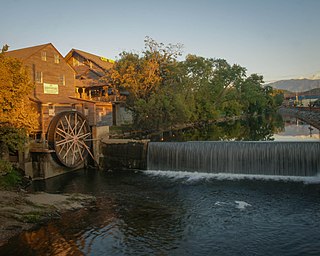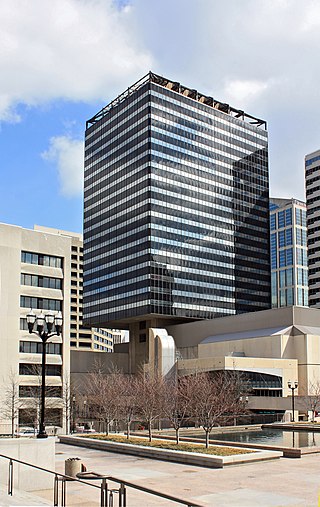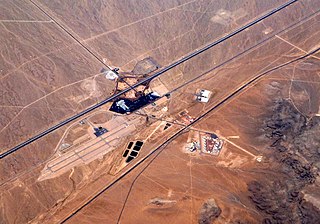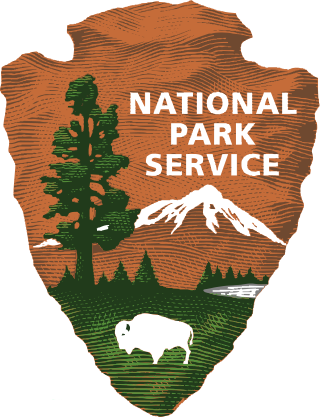
Sevier County is a county of the U.S. state of Tennessee. As of the 2020 census, the population was 98,380. Its county seat and largest city is Sevierville. Sevier County comprises the Sevierville, TN Micropolitan Statistical Area, which is included in the Knoxville-Morristown-Sevierville, TN Combined Statistical Area.

Interstate 59 (I-59) is an Interstate Highway located in the southeastern United States. It is a north–south route that spans 445.23 miles (716.53 km) from a junction with I-10 and I-12 at Slidell, Louisiana, to a junction with I-24 near Wildwood, Georgia.

Gatlinburg is a mountain resort city in Sevier County, Tennessee. It is located 39 miles (63 km) southeast of Knoxville and had a population of 3,944 at the 2010 Census and a U.S. Census population of 3,577 in 2020. It is a popular vacation resort, as it rests on the border of Great Smoky Mountains National Park along U.S. Route 441, which connects to Cherokee, North Carolina, on the southeast side of the national park. Prior to incorporation, the town was known as White Oak Flats, or simply White Oak.

Pigeon Forge is a mountain resort city in Sevier County, Tennessee, United States. As of the 2020 census, the city had a total population of 6,343. Situated just 5 miles (8 km) north of Great Smoky Mountains National Park, Pigeon Forge is a tourist destination that caters primarily to Southern culture and country music fans. The city's attractions include Dollywood and Dollywood's Splash Country, WonderWorks, Alcatraz East Crime Museum, Dolly Parton's Stampede, as well as numerous gift shops, outlet malls, amusement rides, and musical theaters.

A rest area is a public facility located next to a large thoroughfare such as a motorway, expressway, or highway, at which drivers and passengers can rest, eat, or refuel without exiting onto secondary roads. Other names include motorway service area (UK), services (UK), travel plaza, rest stop, oasis (US), service area, rest and service area (RSA), resto, service plaza, lay-by, and service centre (Canada). Facilities may include park-like areas, fuel stations, public toilets, water fountains, restaurants, and dump and fill stations for caravans / motorhomes.

A visitor center or centre, visitor information center or tourist information centre is a physical location that provides information to tourists.

The Tennessee Department of Transportation (TDOT) is the department of transportation for the State of Tennessee, with multimodal responsibilities in roadways, aviation, public transit, waterways, and railroads. It was established in 1915 as the Tennessee Department of Highways and Public Works, and renamed the Tennessee Department of Transportation in 1972. The core agency mission of TDOT is to provide a safe and reliable transportation system for people, goods, and services that supports economic prosperity in Tennessee. Since 1998, TDOT has been ranked amongst the top five in the nation for quality highway infrastructure. It is primarily headquartered in downtown Nashville and operates four regional offices in Chattanooga, Jackson, Knoxville, and Nashville.

The Appalachian Development Highway System (ADHS) is a series of highway corridors in the Appalachia region of the eastern United States. The routes are designed as local and regional routes for improving economic development in the historically isolated region. It was established as part of the Appalachian Regional Development Act of 1965, and has been repeatedly supplemented by various federal and state legislative and regulatory actions. The system consists of a mixture of state, U.S., and Interstate routes. The routes are formally designated as "corridors" and assigned a letter. Signage of these corridors varies from place to place, but where signed are often done so with a distinctive blue-colored sign.

Jean is a small commercial town in Clark County, Nevada, United States, located approximately 20 miles (32 km) south of the Las Vegas hotel-casino corridor along Interstate 15, and 12 mi (19 km) north of the Nevada-California border.

The Foothills Parkway is a national parkway which traverses the foothills of the northern Great Smoky Mountains in East Tennessee, located in the southeastern United States. The 72.1-mile (114 km) parkway will connect U.S. Route 129 along the Little Tennessee River in the west with Interstate 40 (I-40) along the Pigeon River in the east.
The Great Smoky Mountains Parkway is a highway that travels 23.4 miles (37.7 km) between the Great Smoky Mountains National Park and Interstate 40 (I-40) in Kodak, Tennessee, in East Tennessee. It serves as the main thoroughfare for Gatlinburg, Pigeon Forge, and Sevierville, and includes a 4.3-mile (6.9 km) spur of the Foothills Parkway. It is composed of sections of a number of numbered highways, including U.S. Route 441 (US 441) and US 321 and State Route 66 (SR 66) and SR 448.

Interstate 95 (I-95) is a part of the Interstate Highway System that runs north–south from Miami, Florida to Houlton, Maine. The highway enters Maine from the New Hampshire state line in Kittery and runs for 303 miles (488 km) to the Canada–United States border at Houlton. It is the only primary Interstate Highway in Maine. In 2004, the highway's route between Portland and Gardiner was changed so that it encompasses the entire Maine Turnpike, a toll road running from Kittery to Augusta. As an Interstate Highway, all of I-95 in Maine is included in the National Highway System, a network of roads important to the country's economy, defense, and mobility.
The Tennessee Commissioner of Tourist Development is the head of Tennessee's Department of Tourist Development, which is concerned with attracting tourism to the state. The Commissioner is appointed by the governor of Tennessee and is a member of the governor's Cabinet, which meets at least once per month, or more often to the governor's liking.
The Tennessee Department of Environment and Conservation (TDEC) is a Cabinet-level agency first created in 1937 within the government of the U.S. state of Tennessee, headed by the Tennessee Commissioner of Environment and Conservation.
The Iowa Department of Transportation is the government organization in the U.S. state of Iowa responsible for the organization, construction, and maintenance of the primary highway system. Located in Ames, Iowa, DOT is also responsible for licensing drivers and programming and planning for aviation, rail, and public transit.

The Pigeon Forge Police Department, sometimes referred to as "PFPD", is the primary law enforcement organization serving Pigeon Forge, Tennessee in the United States.

Wears Valley is an unincorporated community in Sevier County, Tennessee that was formerly treated by the U.S. Census Bureau as a census county division. As of the 2000 Census, the population of Wears Valley was 6,486.
The West Virginia Department of Transportation (WVDOT) is the state agency responsible for transportation in the U.S. state of West Virginia. The Department of Transportation serves an umbrella organization for four subsidiary agencies which are directly responsible for different areas of the state's infrastructure.

U.S. Route 23 (US 23) is a part of the United States Numbered Highway System that travels from Jacksonville, Florida, to Mackinaw City, Michigan. In the U.S. state of Tennessee, the highway travels 57.48 miles (92.51 km) in the northeastern part of the state from the North Carolina state line at Sam's Gap in the Bald Mountains to the Virginia state line in Kingsport. The entire route in Tennessee is a four-lane controlled-access highway and is concurrent with Interstate 26 (I-26) for most of its length. The freeway is also designated the James H. Quillen Parkway for its entire length in Tennessee. US 23 in Tennessee is part of Corridor B of the Appalachian Development Highway System (ADHS) and serves as a major thoroughfare in the Tri-Cities region of the state. Although I-26 is technically an east–west route, the highway predominantly travels in a north–south alignment in the state. The highway reaches a maximum elevation of 3,760 feet (1,150 m) at the North Carolina state line, which is the highest elevation on the Interstate Highway System east of the Mississippi River.
Welcome centers, also commonly known as visitors' centers, visitor information centers, or tourist information centers, are buildings located at either entrances to states on major ports of entry, such as interstates or major highways, e.g. U.S. Routes or state highways, or in strategic cities within regions of a state, e.g. Southern California, Southwest Colorado, East Tennessee, or the South County region of Rhode Island. These welcome centers, which first opened on May 4, 1935 next to U.S. Route 12 in New Buffalo, Michigan, are locations that serve as a rest area for motorists, a source of information for tourists or new residents that enter a state or a region of a state, and a showcase for the state. These features make welcome centers, visitors centers, and service plazas, which are similar to welcome centers, distinct from rest areas. In Alaska and Hawaii, their unique geographical locations preclude them from having welcome centers as known in the rest of the U.S.














